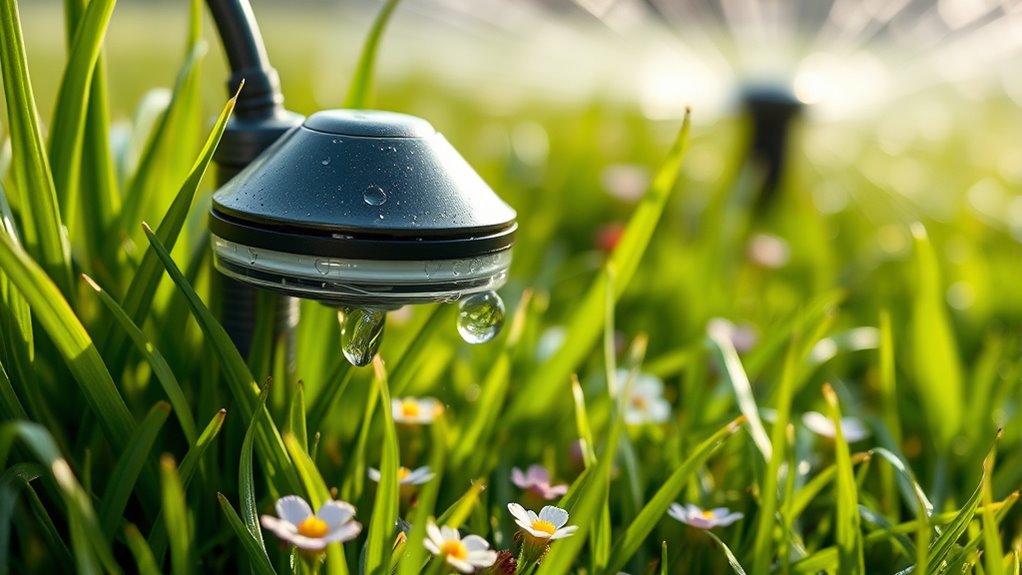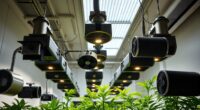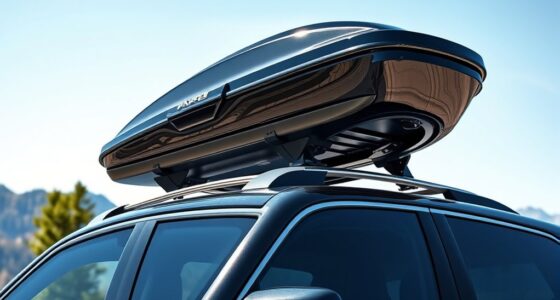If you’re looking to save water and keep your lawn healthy, I recommend checking out the top rain sensors designed for irrigation systems. These devices automatically pause watering when it starts to rain and resume when conditions improve, preventing overwatering. Some models also include freeze sensors to protect pipes. Choosing the right sensor depends on compatibility, durability, and features. Keep exploring to find the best options that match your needs and enhance your garden’s health.
Key Takeaways
- Select sensors compatible with existing irrigation controllers for seamless integration and reliable performance.
- Prioritize adjustable rainfall sensitivity to customize watering pauses based on weather conditions.
- Opt for durable, weather-resistant models designed to withstand severe outdoor environments.
- Consider wireless sensors for easy installation and minimal wiring, especially in hard-to-wire locations.
- Choose sensors with additional features like freeze detection and easy mounting options to enhance lawn health and water savings.
Orbit 57069N Rain and Freeze Sensor for Sprinkler Controllers

Are you looking for a reliable rain sensor that can automatically protect your sprinkler system from overwatering and freezing? The Orbit 57069N Rain and Freeze Sensor is an excellent choice. It detects rain and low temperatures, suspending watering during storms or freezing conditions, then resuming when it’s safe. Adjustable rainfall thresholds from 1/8 to 1 inch let you customize sensitivity. Easy to install on eaves or fences, it connects with various 24 VAC controllers. Its water-absorbing disks expand when wet, triggering suspension, while a built-in thermistor prevents pipe freeze damage. This durable, weather-resistant sensor guarantees efficient watering and water conservation.
Best For: homeowners or landscape professionals seeking an easy-to-install, weather-resistant sensor to prevent overwatering and freezing damage in automated sprinkler systems.
Pros:
- Adjustable rainfall sensitivity from 1/8 to 1 inch for customized protection
- Easy to install on eaves or fences with included adapters
- Reliable detection of rain and low temperatures to suspend and resume watering automatically
Cons:
- Discontinued by manufacturer, potentially affecting availability or support
- Some users report the need for additional components like relays for full automation integration
- Limited to 30-foot wire runs, which may require extensions for larger properties
Hunter Rain Clik Wireless Rain Sensor System
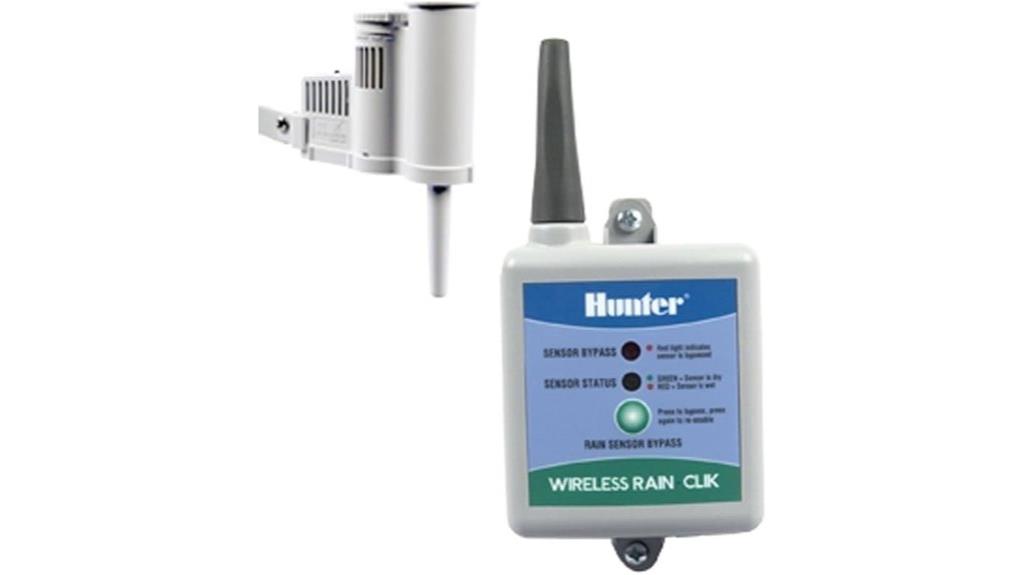
The Hunter Rain Clik Wireless Rain Sensor System is an excellent choice for homeowners and landscapers who want a reliable, easy-to-install solution to prevent overwatering. It mounts simply on gutters, walls, or fences, with a gutter edge option, and pairs automatically with most irrigation controllers, making setup quick and straightforward. The sensor detects rain immediately, shutting off sprinklers at the first sign of rain, saving water and promoting healthy lawns. With minimal wiring and clear instructions, installation typically takes less than an hour. Its durable design and long-lasting battery ensure dependable performance, making it a smart, hassle-free addition to any irrigation system.
Best For: homeowners and landscapers seeking a reliable, easy-to-install rain sensor system to prevent overwatering and conserve water.
Pros:
- Easy to install within 30 minutes with minimal wiring required
- Detects rain immediately, shutting off sprinklers at onset to prevent overwatering
- Durable design with a long-lasting battery that lasts 5-7 years
Cons:
- Heavy hail or severe weather can damage the sensor, limiting its effectiveness in extreme climates
- Requires periodic battery replacement, although it is straightforward
- Compatibility may vary with some older or specialized irrigation controllers
Rain Bird CPRSDBEX Wired Rain Sensor with Mounting Bracket and Wire, Gray

If you’re looking for a reliable rain sensor that automatically protects your irrigation system from overwatering, the Rain Bird CPRSDBEX Wired Rain Sensor is an excellent choice. It features adjustable rainfall settings from 1/8 to 3/4 inches, easily controlled with a twist dial, and includes an adjustable vent ring for drying after rain. The durable, UV-resistant body and aluminum mounting bracket ensure long-term performance in harsh environments. It connects seamlessly to most irrigation controllers, compatible with low-voltage 24VAC circuits. With 25 feet of extension wire, simple mounting options, and a compact design, it’s a user-friendly solution to conserve water and keep your lawn healthy.
Best For: homeowners and landscape professionals seeking an easy-to-install, reliable rain sensor to prevent overwatering and conserve water during rainy conditions.
Pros:
- Adjustable rainfall settings from 1/8 to 3/4 inches for customized performance
- Durable, UV-resistant construction suitable for harsh outdoor environments
- Easy to connect to most irrigation controllers with included extension wire
Cons:
- Not recommended for high-voltage pump circuits, limiting some applications
- Requires manual toggling on controllers to activate the sensor, which may be overlooked
- Limited to low-voltage 24VAC systems, potentially incompatible with certain existing setups
Hunter Sprinkler MINICLIK Rain Sensor
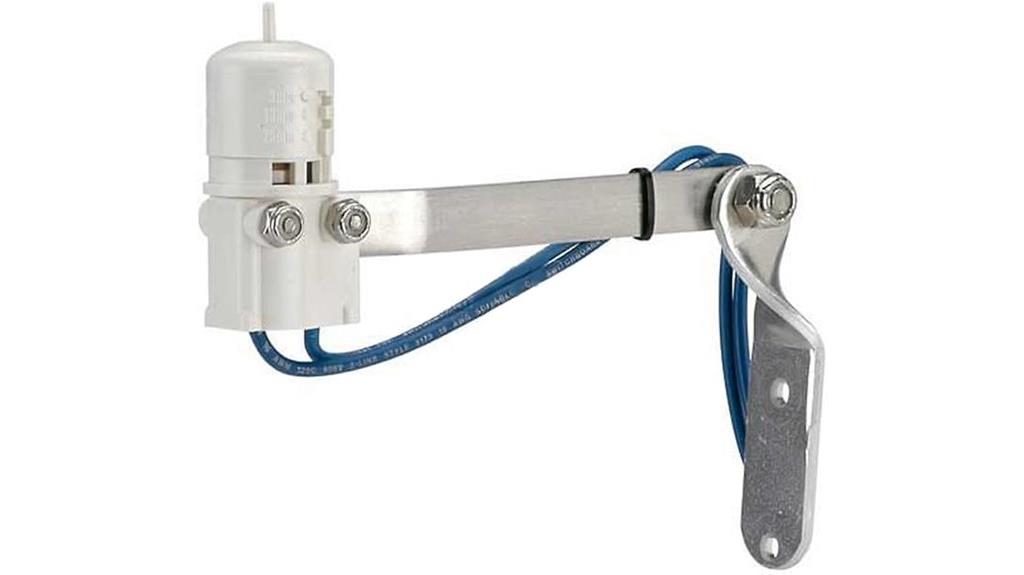
For homeowners seeking an easy-to-install rain sensor that seamlessly integrates with their existing irrigation system, the Hunter Sprinkler MINICLIK Rain Sensor stands out. It’s a lightweight, durable device featuring tipping bucket technology that detects rain and automatically halts watering when needed. Installation is straightforward with provided hardware, and it works well with Hunter controllers like the ProC. I appreciate its simple operation, weather-resistant design, and ability to prevent overwatering, saving water and keeping my lawn healthy. Despite some initial wiring tips, I found it reliable and effective, making it a practical choice for any garden or outdoor irrigation setup.
Best For: homeowners seeking an easy-to-install, reliable rain sensor that seamlessly integrates with their existing irrigation system to prevent overwatering.
Pros:
- Easy to install with provided hardware and straightforward wiring
- Weather-resistant design ensures durability in outdoor conditions
- Effectively detects rain and automatically halts watering, saving water and protecting plants
Cons:
- Initial setup and operation checks may cause some confusion for users
- Batteries are not included, requiring additional purchase
- Slight variations in responsiveness may occur depending on rain intensity and controller compatibility
Rainbird Wireless Rain and Freeze Sensor System

Anyone looking to optimize water conservation in a residential irrigation system should consider the Rainbird Wireless Rain and Freeze Sensor System. This setup includes a controller interface and a sensor that automatically stops watering during rain or freezing temperatures, saving up to 35% water. It’s compatible with most 24VAC controllers, excluding Rain Bird’s ESP-SMT and ESP-SMTe models. The system features an intuitive, icon-driven interface with adjustable rainfall and temperature settings. Easy to install and reliable, it’s praised for stable wireless signals and convenient indoor adjustments. Overall, it’s a smart choice for those seeking efficient, water-saving irrigation control.
Best For: homeowners and landscape professionals seeking an easy-to-install, water-saving irrigation control system that automatically responds to rain and freeze conditions.
Pros:
- Reliable wireless connection with enhanced antenna for stable signal transmission
- Easy indoor adjustments with an intuitive, icon-driven interface and customizable settings
- Compatible with most 24VAC controllers, offering versatile integration options
Cons:
- Not compatible with Rain Bird ESP-SMT or ESP-SMTe smart controllers
- Mounting may not fit standard gutters, potentially requiring additional mounting solutions
- Limited to adjustable rainfall from 1/8 to 1/2 inch and temperatures from 33°F to 41°F, which may not suit all climates
Rain Bird – WR2-RFC – Wireless Rain/Freeze Sensor Complete Kit
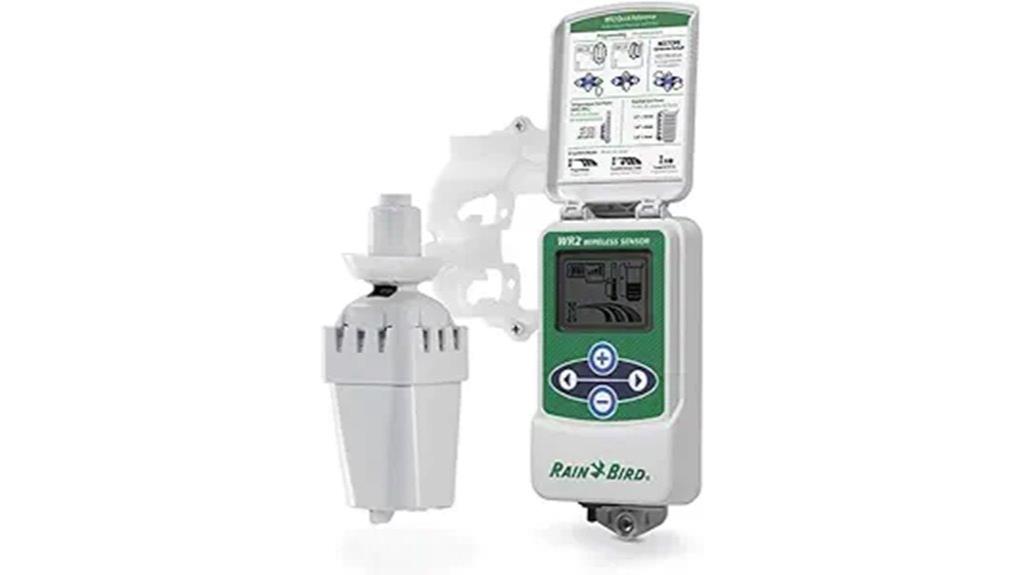
The Rain Bird WR2-RFC Wireless Rain/Freeze Sensor Complete Kit stands out as an excellent choice for homeowners and irrigation professionals seeking a reliable, easy-to-install solution that automatically adjusts watering schedules based on real-time weather conditions. Its user-friendly design supports quick, one-person installation with a versatile mounting bracket suitable for gutters, fences, or walls. The sensor detects rain and freezing temperatures, reducing water waste by up to 35%. Dual antennas ensure a strong signal, even through obstacles. With an easy-to-read LCD, adjustable thresholds, and durable construction, it’s a dependable addition that helps keep your lawn healthy while conserving water.
Best For: homeowners and irrigation professionals seeking an easy-to-install, weather-responsive sensor to optimize watering schedules and conserve water.
Pros:
- Easy one-person installation with versatile mounting options for gutters, fences, or walls
- Reliable signal with dual antennas that penetrate obstructions and walls
- Adjustable rainfall and freeze temperature settings for customized protection
Cons:
- Mounting hardware not included, requiring additional purchase
- Not compatible with some Rain Bird smart controllers like ESP-SMT and SST series
- Batteries may need replacement annually, depending on usage and mounting location
Irritrol RS1000 Wireless Rain Sensor
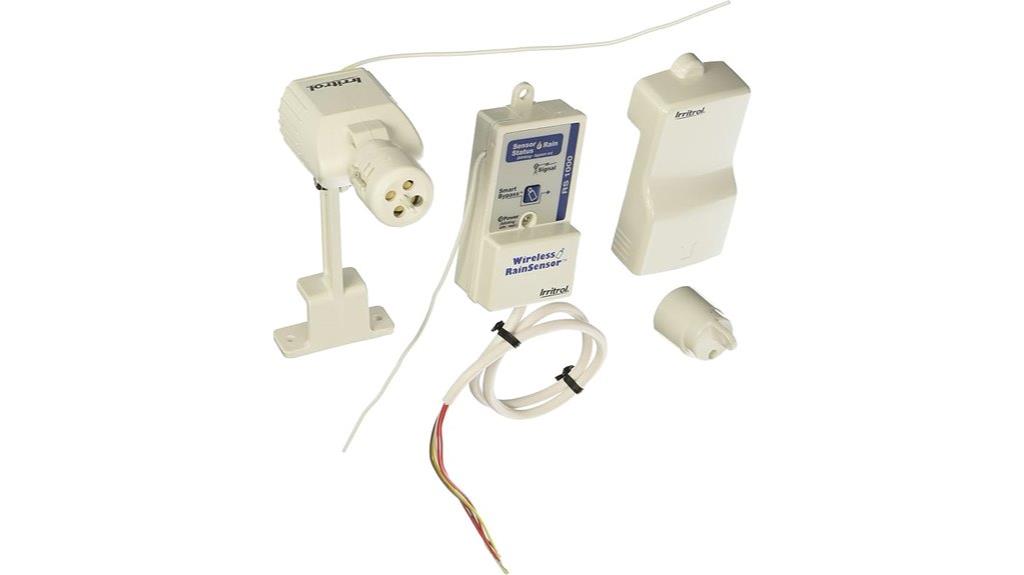
The Irritrol RS1000 Wireless Rain Sensor stands out as an ideal choice for irrigation system users seeking reliable, hassle-free rain detection without the need for external wiring. Its patented wireless technology ensures constant communication between transmitter and receiver, even during power outages. With adjustable rain thresholds and a compact design, installation is quick and straightforward—often in under 10 minutes. The sensor effectively stops watering during rain and helps prevent freeze damage. Compatible with standard controllers, it offers flexible mounting options and user-friendly features like signal indicators. Overall, the RS1000 provides dependable, maintenance-free rain sensing that conserves water and protects your lawn year-round.
Best For: homeowners and irrigation professionals seeking a reliable, wireless rain sensor that simplifies installation and enhances water conservation efforts.
Pros:
- Wireless technology ensures consistent communication even during power outages
- Easy and quick installation typically under 10 minutes
- Adjustable rain thresholds and compact design for versatile use
Cons:
- Short receiver cord (~14 inches) may limit mounting options
- Small thumbscrews for gutter mounting can be difficult to handle
- Limited wiring length could require additional extension accessories
K Rain Hardwired Rain Sensor
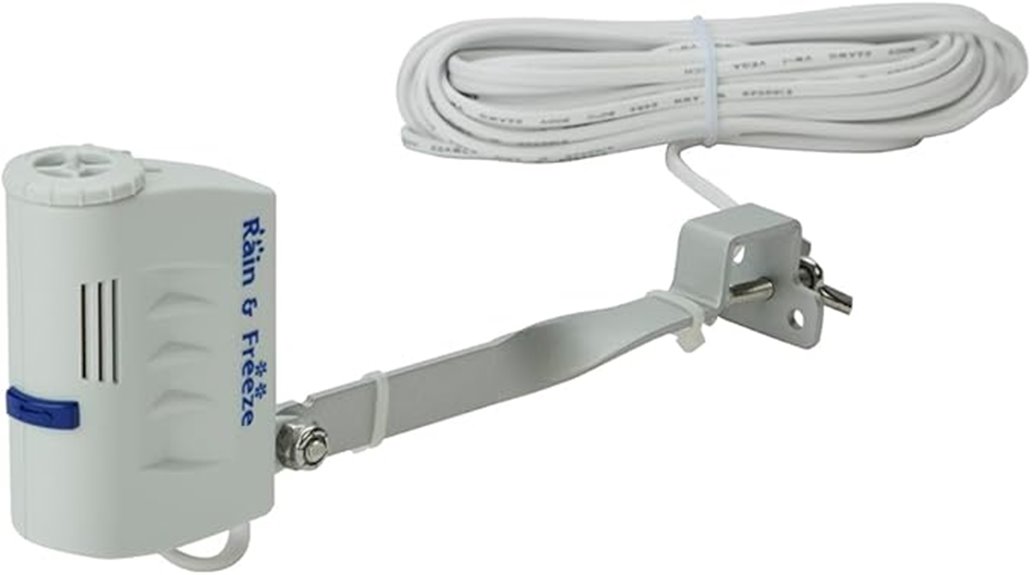
If you’re looking to efficiently conserve water and protect your landscape from overwatering, the K Rain Hardwired Rain Sensor is an excellent choice. It detects rainfall and freezing temperatures, automatically suspending your irrigation system when needed. With flexible, easy-to-adjust rainfall settings, it guarantees ideal control tailored to your climate. This reliable 2-in-1 hardwired sensor seamlessly integrates with your existing system, making water management straightforward. Its compact design (8 x 4 x 2 inches) and durable build guarantee long-lasting performance. Plus, with warranty options and customer support, you can trust it to help keep your lawn healthy while saving water.
Best For: homeowners and landscape managers seeking an efficient, reliable way to conserve water and prevent overwatering during rainy or freezing conditions.
Pros:
- Easy to adjust flexible rainfall settings for customized control
- Seamless integration with existing irrigation systems
- Durable, compact design ensures long-lasting performance
Cons:
- Requires hardwired installation, which may be complex for some users
- Limited to detecting rainfall and freezing temperatures, not other weather conditions
- No wireless or battery-powered options for easier setup
Rain Sensor Replacement Discs for Rain Bird Irrigation Sensors
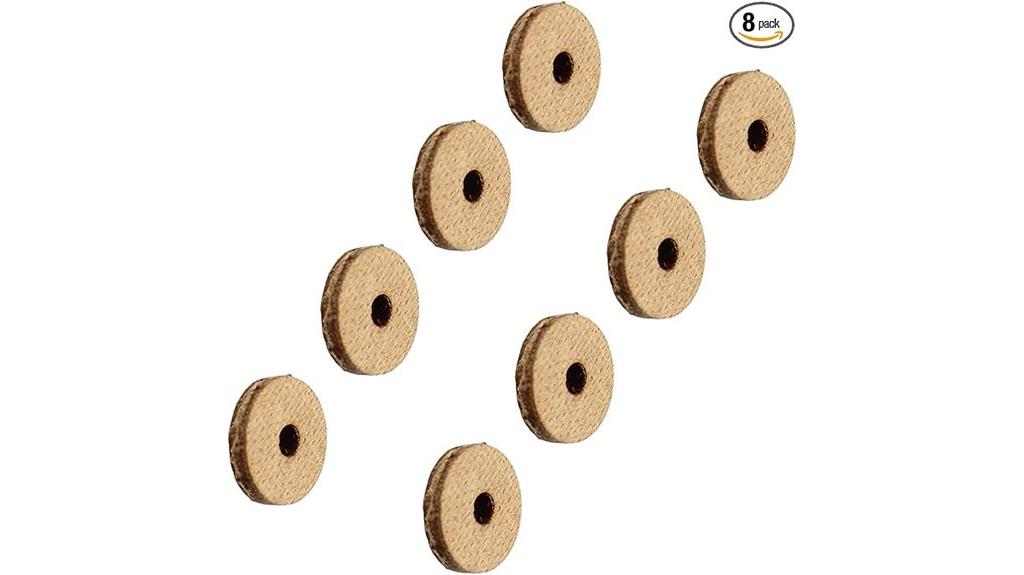
When maintaining Rain Bird irrigation sensors, choosing compatible replacement discs is essential for ensuring accurate rain detection. These hygroscopic cork discs expand when wet, activating the switch, and contract as they dry, resetting the sensor. The package typically includes 8 high-quality discs that respond sensitively to moisture changes, helping your system function correctly. Discs usually last 3-5 years but should be replaced if they turn black, lose elasticity, or cause false readings. Proper installation ensures your sensor stays responsive. I recommend keeping spare discs handy, as they’re affordable and crucial for maintaining reliable rain detection and efficient watering.
Best For: homeowners and professionals seeking reliable, easy-to-install replacement discs to maintain optimal rain sensor performance for Rain Bird irrigation systems.
Pros:
- Compatible with multiple Rain Bird models, ensuring versatile use.
- Made of durable cork, providing sensitive moisture response and longevity.
- Affordable and includes multiple discs for long-term maintenance.
Cons:
- Discs may need adjustment for optimal sensitivity depending on climate and setup.
- Some users might receive more discs than needed or in varying quantities.
- Proper installation is crucial; incorrect placement can affect sensor accuracy.
Rain Bird RSD-BEX Rain Sensor w/Aluminum Latching Bracket & Extension Wire
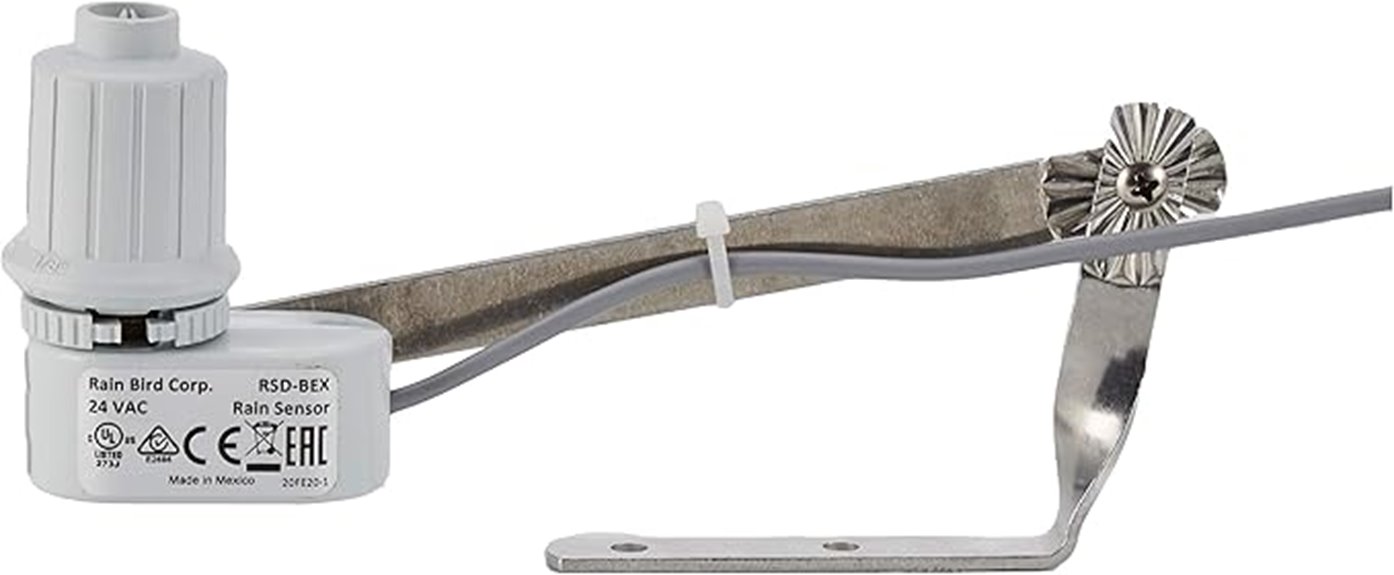
For those seeking a reliable rain sensor compatible with a range of irrigation systems, the Rain Bird RSD-BEX stands out with its hydroscopic discs that detect rainfall effectively. Designed specifically for Rainbird electronics technology, it supports up to ten 24VAC solenoid valves and one master valve, making it versatile for residential and commercial setups. The sensor features adjustable rainfall settings from 1/8 to 3/4 inches, along with a vent ring to prevent overwatering. Its durable UV-resistant polymer body and rugged aluminum bracket ensure longevity outdoors. With simple installation and positive customer feedback, the RSD-BEX helps save water while keeping your lawn healthy.
Best For: homeowners and landscape professionals seeking a durable, easy-to-install rain sensor compatible with 24VAC irrigation systems to efficiently prevent overwatering.
Pros:
- Easy installation with straightforward wiring and adjustable rainfall settings
- Durable construction with UV-resistant polymer and rugged aluminum bracket
- Supports multiple valves and integrates seamlessly with existing controllers
Cons:
- Only compatible with Rainbird electronics technology, limiting cross-brand use
- May require trial-and-error adjustments for optimal performance
- Some users recommend disconnecting common wires to prevent pump burnout during installation
Hunter Company Wired Mini-Clik Rain Sensor

The Hunter Company Wired Mini-Clik Rain Sensor is an excellent choice for homeowners and landscape professionals seeking a reliable, easy-to-install device that automatically prevents watering during rainfall. It detects rainfall from ⅛ to ¾ inches, halting irrigation to conserve water and prevent overwatering. Compatible with all Hunter controllers and most other brands, it’s straightforward to set up with just two wires. Its debris-tolerant design guarantees consistent performance in various environments, and the included 25 feet of UL-approved wire makes placement flexible. Customers praise its accuracy, durability, and simple installation, making it a smart addition for efficient, water-saving irrigation systems.
Best For: homeowners and landscape professionals seeking a reliable, easy-to-install rain sensor to optimize irrigation efficiency and conserve water.
Pros:
- Easy to install with straightforward two-wire connection.
- Highly reliable and debris-tolerant for consistent performance.
- Compatible with all Hunter controllers and most other brands, offering versatile use.
Cons:
- Limited to detecting rainfall from ⅛ to ¾ inches, which may not suit all watering preferences.
- Requires 25 feet of wire for installation, which might be excessive for very small landscapes.
- Needs to be manually mounted and positioned to ensure proper rain detection.
Hunter Sprinkler RainClik Rain Sensoring Irrigation Control
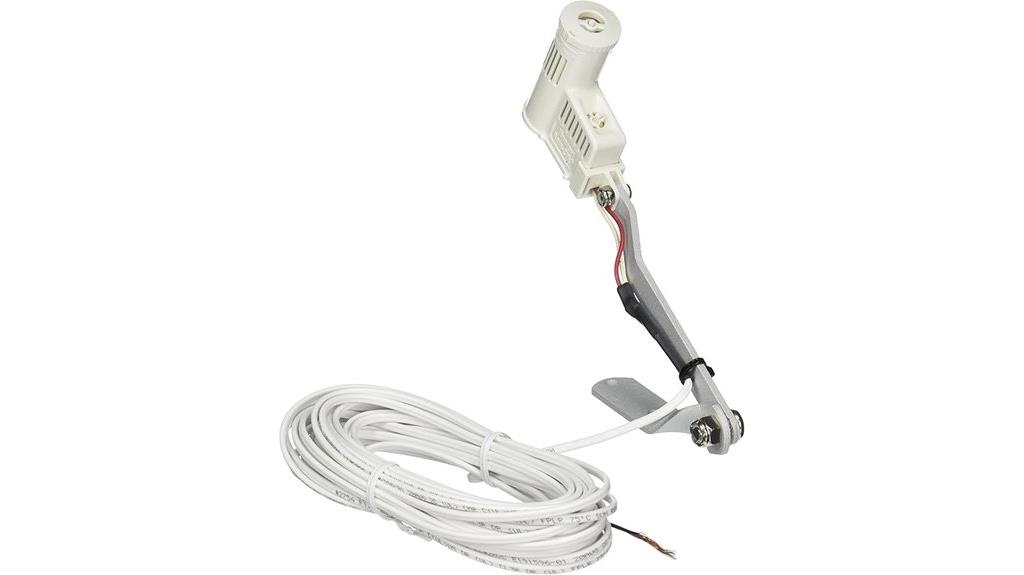
If you want a reliable rain sensor that quickly stops your sprinkler system during rainfall, the Hunter Sprinkler RainClik Rain Sensoring Irrigation Control is an excellent choice. This hardwired sensor uses Quick Response technology to detect rain early and shut off your controller immediately, preventing overwatering. Made of durable plastic, it’s easy to install on eaves, walls, or gutters with optional mounts. Its design allows you to adjust response speed by controlling the air vent opening. With a 5-year warranty and proven reliability, it’s an effective way to conserve water, reduce runoff, and keep your lawn healthy during rainy seasons.
Best For: homeowners and professional landscapers seeking a reliable, easy-to-install rain sensor to prevent overwatering and conserve water during rainy periods.
Pros:
- Quick Response technology detects rain early, shutting off the system promptly
- Durable plastic construction with multiple mounting options for versatile installation
- 5-year warranty ensuring long-term reliability and support
Cons:
- Setup and wiring can be complex, especially with newer controller models
- Some users have experienced sensor failures or false alarms due to manufacturing defects or wiring issues
- Adjusting response speed requires manual vent control, which may require some trial and error
Hunter Sprinkler RainClik Rain Sensoring Irrigation Control

Hunter’s RainClik Rain Sensor stands out for its quick response and reliable instant shutoff, making it an excellent choice for homeowners who want to prevent overwatering during rain. Its maintenance-free, patented sensing mechanism guarantees long-term, dependable operation. The sensor features modular mounting options and an adjustable irrigation restart that adapts to different rain levels, enhancing efficiency. Easy to install, it comes with a 25-foot wire and takes about 10 minutes to set up. Compatible with most automatic controllers, it’s a smart investment to protect your lawn while conserving water. Customers praise its reliability and straightforward installation, though some note occasional performance issues.
Best For: homeowners and professional landscapers seeking a reliable, easy-to-install rain sensor to prevent overwatering and conserve water during rain events.
Pros:
- Quick response and reliable instant shutoff for effective rain detection
- Maintenance-free patented sensing mechanism ensures long-term durability
- Modular mounting options and adjustable irrigation restart enhance versatility and customization
Cons:
- Some users experience occasional malfunctions or bypass issues during manual operation
- Performance consistency may vary, leading to dissatisfaction in rare cases
- Price comparison and availability can be limited, prompting some to seek alternatives
Rain Bird WR2RFC48 A554800 WR2 Rain/Freeze Sensor Combo w/ 48H Hold
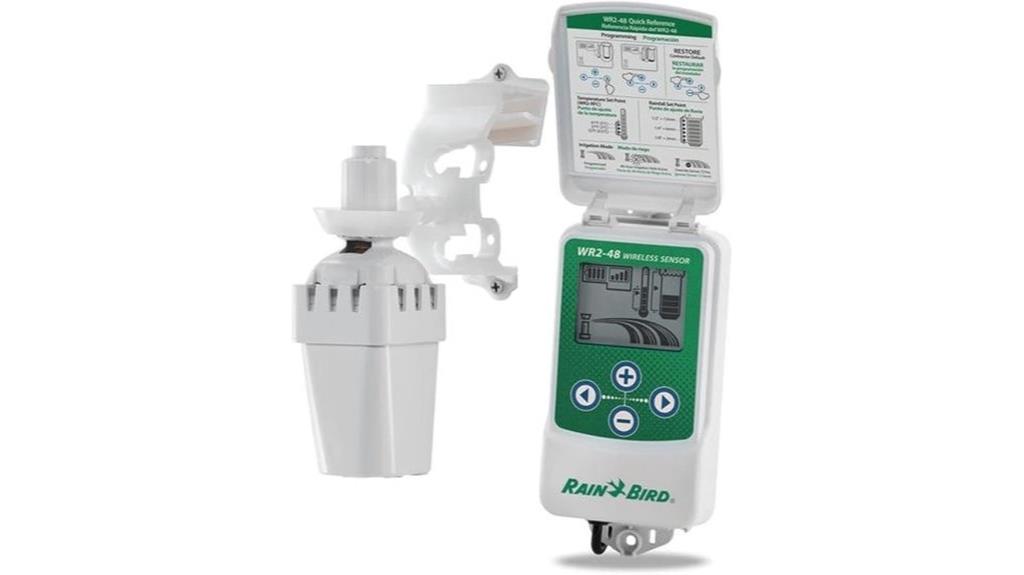
For homeowners and commercial landscapers seeking reliable weather-based irrigation control, the Rain Bird WR2RFC48 A554800 Rain/Freeze Sensor Combo stands out. It automatically pauses watering for 48 hours after rainfall and activates the freeze sensor when temperatures drop, protecting plants from damage. Easy to install and compatible with Rain Bird controllers, it offers wireless connectivity for flexible placement. Many users praise its accuracy, durability, and simple setup, helping save up to 35% water. The device’s intuitive interface and support for additional delay options make it a versatile, cost-effective choice for maintaining healthy lawns while complying with local water regulations.
Best For: homeowners and commercial landscapers seeking reliable, weather-based irrigation control to conserve water and prevent freeze damage.
Pros:
- Easy to install and set up, often within 30 minutes
- Wireless connectivity allows flexible placement without line-of-sight issues
- Accurate rain and freeze detection helps save up to 35% water usage
Cons:
- Limited to Rain Bird controllers; may require additional wiring for compatibility
- Some users recommend extra hardware, like clamping screws, for secure mounting in windy areas
- The device’s compact size may limit certain mounting options in complex landscape setups
Rain Sensor for Garden Water Timer and Sprinkler Controller

Rain sensors for garden water timers and sprinkler controllers are ideal for homeowners seeking to automate watering while conserving water. These sensors detect rainfall from 1/8” to 1”, automatically interrupting and restarting your irrigation system to prevent overwatering. They’re easy to install using a universal mounting bracket, fitting on rain gutters, roof sides, or angled surfaces. No batteries are needed, and the sensitivity can be adjusted for more precise control. Compact and lightweight, these sensors help reduce water waste, lower bills, and keep your lawn healthy without complicated setups. They’re a simple, effective addition to any existing irrigation system.
Best For: homeowners and gardeners seeking an easy-to-install, water-conserving rain sensor to automate and optimize their irrigation systems.
Pros:
- Automatically prevents overwatering by detecting rainfall from 1/8” to 1”
- Easy to install with a universal mounting bracket suitable for gutters, roof sides, or angled surfaces
- No batteries required, reducing maintenance and ensuring reliable operation
Cons:
- Should not be submerged or installed inside rain gutters, limiting placement options
- Sensitivity adjustment may require trial and error for optimal performance
- Limited to use with compatible irrigation controllers that support rain sensor integration
Factors to Consider When Choosing a Rain Sensor for Irrigation Systems

When choosing a rain sensor, I consider how well it works with my existing controller and the options it offers for sensitivity adjustment. I also look at its weather resistance, durability, and how easy it is to install and customize. Finally, I check its power source and wiring needs to guarantee it fits my setup perfectly.
Compatibility With Controllers
Choosing a rain sensor that works seamlessly with your irrigation controller starts with guaranteeing compatibility. First, check that the sensor’s voltage requirements match your system’s, usually 24VAC. Next, verify if the wiring type—hardwired or wireless—fits your controller’s connection options. It’s also important to confirm that the sensor’s communication protocol, whether analog, digital, or wireless, aligns with your controller’s input ports. Additionally, ensure the sensor supports your specific brand or model to avoid integration issues. Some sensors offer extra features like freeze detection or adjustable rainfall thresholds; make sure these are compatible with your system’s capabilities. By paying attention to these factors, you’ll ensure a smooth setup that effectively automates watering based on actual weather conditions.
Sensitivity Adjustment Options
Adjustable sensitivity settings are essential for tailoring your rain sensor to match your local climate and watering needs. These options let you set the rainfall amount that triggers the system, typically between 1/8 inch and over 1 inch. By customizing sensitivity, you can prevent false alarms from light rain or mist, ensuring watering only happens during significant rainfall. This feature allows calibration based on your regional climate—whether it’s dry or rainy—optimizing water conservation. Many sensors include dial or switch controls for easy adjustments, often without tools or disassembly. Proper sensitivity calibration guarantees your irrigation system responds appropriately to actual rain, reducing unnecessary watering and water waste while keeping your lawn healthy and well-maintained.
Weather Resistance Durability
Durability is a critical factor when selecting a rain sensor, as outdoor conditions can be harsh and unpredictable. I look for sensors made from weather-resistant materials like UV-resistant polymer or corrosion-proof metals, which withstand sun, rain, and wind. Sealed enclosures are essential, protecting internal components from moisture, dirt, and debris, guaranteeing consistent performance over time. Weatherproof seals and gaskets prevent water damage and corrosion, even in harsh climates. Rugged, impact-resistant housings help avoid damage from hail, falling branches, or accidental impacts. Regular maintenance, including checking seals and mounting hardware, is essential for long-term durability. Choosing a sensor with these features ensures reliable operation and protects your investment, keeping your irrigation system functioning effectively regardless of outdoor conditions.
Installation Ease and Flexibility
When selecting a rain sensor, ease of installation and flexibility are key factors that can save you time and effort. Look for sensors with versatile mounting options like rooftops, gutters, fences, or open areas to guarantee maximum exposure to rainfall. Choose models that are straightforward to install, requiring minimal tools, wiring, or technical knowledge for quick setup. Check if the sensor offers adjustability features such as rainfall sensitivity or drying time, allowing you to customize performance to your environment. Ensure compatibility with different irrigation controllers, whether wired or wireless, for seamless integration. Additionally, evaluate the power source options and wiring flexibility to match your existing system without the need for extensive modifications. These considerations make installation easier and guarantee the sensor fits your setup perfectly.
Power Source and Wiring
Choosing the right power source and wiring setup is essential for ensuring your rain sensor works reliably over time. Hardwired sensors connect directly to your irrigation controller, so proper wiring—following manufacturer instructions for correct polarity—is vital for dependable operation. Wireless rain sensors eliminate extensive wiring, operating via radio signals, but still need a power source like batteries or solar power. The power source impacts installation flexibility: hardwired sensors depend on the controller’s power, while wireless models offer more placement options. Ensuring stable power and correct wiring connections helps maintain the sensor’s responsiveness and durability in outdoor conditions. Proper setup prevents false triggers and prolongs the sensor’s lifespan, making your irrigation system more efficient and reliable year-round.
Additional Features and Settings
Selecting a rain sensor with the right features can substantially enhance your irrigation system’s efficiency and adaptability. Many sensors offer adjustable rainfall detection thresholds, from 1/8 inch to 1 inch, so you can customize based on your local climate. Some include drying control features, like adjustable vent rings or timers, ensuring the system resets properly after rain. Wireless sensors often provide programmable delay periods, such as 48 or 72 hours, to prevent immediate restarts. Others have freeze detection with adjustable temperature settings, protecting your system during cold snaps. Additional features like signal strength indicators, LCD displays, and compatibility with various controllers can also help you monitor and control your system more effectively. These options let you tailor your irrigation to your lawn’s specific needs.
Frequently Asked Questions
How Do Rain Sensors Impact Overall Water Savings in Irrigation?
Rain sensors considerably impact water savings by preventing unnecessary irrigation when it’s already raining. I’ve seen how installing one reduces water waste, especially during rainy seasons. They automatically turn off your sprinkler system when moisture is detected, ensuring your lawn gets just the right amount of water. This not only conserves water but also lowers your utility bills. Overall, rain sensors are an efficient way to make your irrigation smarter and eco-friendly.
Are Rain Sensors Compatible With All Sprinkler Controller Brands?
I’ve found that rain sensors aren’t universally compatible with all sprinkler controllers. Some brands and models are designed to work seamlessly with certain sensors, while others may require adapters or specific types. I recommend checking your controller’s manual or contacting the manufacturer to verify compatibility before purchasing a rain sensor. This way, you can avoid any installation issues and ensure your system saves water effectively.
What Maintenance Is Required for Optimal Rain Sensor Performance?
Think of your rain sensor as the watchdog of your irrigation system. To keep it performing at its best, I check it regularly for dirt, debris, or damage, especially after storms. I also ascertain the sensor’s location isn’t obstructed by overgrown plants or objects. Occasionally, I clean the sensor with a soft cloth and verify the wiring and connections. Proper maintenance keeps your system running smoothly and conserves water effectively.
Can Rain Sensors Be Installed Indoors or Only Outdoors?
I’d say rain sensors are designed primarily for outdoor use, since they need to detect weather conditions directly. Installing one indoors wouldn’t be practical or effective because they rely on exposure to rain, humidity, and sunlight to operate correctly. If you’re looking to monitor indoor moisture or humidity, a different device like a hygrometer might be better suited. So, for ideal performance, keep rain sensors outside where they can do their job.
How Do Temperature Variations Affect Rain Sensor Accuracy?
Imagine a rain sensor as a vigilant guardian watching the skies. Temperature swings can trick this guardian, making it believe rain is falling when it’s just chilly air or vice versa. Extremes in temperature can cause the sensor’s components to misread moisture levels, reducing accuracy. I’ve seen this happen and suggest choosing sensors with temperature compensation features to keep your irrigation system reliably smart, rain or shine.
Conclusion
Choosing the right rain sensor is like giving your lawn a loyal guardian—one that knows when to water and when to rest. With options tailored to different needs, you can effortlessly save water and keep your yard lush. Remember, a good rain sensor isn’t just a gadget; it’s the silent hero of a thriving garden. So, why not let nature and technology work together for a greener, healthier lawn?
